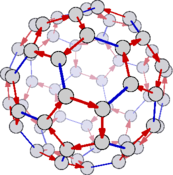Reviewing what we have learned about group theory and the platonic solids so far.
The tetrahedral symmetries are isomorphic to A4, the alternating group on four elements. The tetrahedron has 4 faces, 4 vertices and 6 edges, and it is self-dual. We create the dual by switching the faces and vertices. The group's order is 12.
The cube (6 faces, 8 vertices, 12 edges) and the octahedron (8 faces, 6 vertices, 12 edges) are duals, and their groups of symmetries have order 24 and are isomorphic to S4. A4 is a subgroup of S4 and a regular tetrahedron can be embedded in a cube. The cube can be embedded in a regular octahedron and vice versa, which is always the case with dual polyhedra.
So now we move on to the two largest Platonic solids, the 12-sided regular dodecahedron and the 20-sided regular icosahedron.
As you might expect, the dodecahedron (12 faces, 20 vertices, 30 edges) and the icosahedron (20 faces, 12 vertices, 30 edges) are duals, so I will represent them as a subgroup of S12, the smaller of our two choices of symmetric groups. The order of the group is 60.
Being a nerd, of course I had a 12-sided die just lying around, and I used the numbering convention from one of these. (This picture was nicked from Dice Game Depot, a fine web establishment for all your dice needs.)
Opposite sides always sum to 13, so the opposite pairs are 12 & 1, 11 & 2, 10 & 3, 9 & 4, 8 & 5 and 7 & 6. I changed 10, 11 and 12 to a, b and c, so that every face was represented by a single character.
Here are our conjugacy classes.
As always, the identity stands alone.
(1)
==
There are 15 elements of order 2, and they are six transpositions. To visualize this, think about holding the dodecahedron with you forefinger and thumb on two opposite edges, and spin the die 180°. Since there are 30 edges, there are 15 pairs we can use.
(1c)(3a)(47)(28)(96)(b5)
(1c)(2b)(9a)(57)(43)(86)
(1c)(49)(27)(8a)(b6)(53)
(1c)(67)(23)(48)(ba)(95)
(1c)(58)(7a)(29)(63)(b4)
(58)(67)(12)(4a)(cb)(93)
(2b)(58)(13)(46)(ac)(97)
(3a)(58)(14)(26)(c9)(b7)
(2b)(49)(15)(6a)(c8)(73)
(3a)(2b)(16)(54)(c7)(89)
(49)(58)(17)(2a)(c6)(b3)
(3a)(67)(18)(24)(c5)(b9)
(2b)(67)(19)(a5)(c4)(38)
(49)(67)(1a)(25)(c3)(b8)
(3a)(49)(1b)(65)(c2)(78)
Every such permutation will send two different pairs of faces to their opposite numbers, and those two transpositions are always the first two in the list.
These are even permutations.
==
Next are the 20 elements of order 3. To visualize these, spin the die around two opposite vertices. The inverses are written on the same lines with the "&" between them.
(124)(cb9)(357)(a86) & (142)(c9b)(375)(a68)
(146)(c97)(a8b)(352) & (164)(c79)(ab8)(325)
(165)(c78)(239)(ba4) & (156)(c87)(293)(b4a)
(15a)(c83)(4b7)(926) & (1a5)(c38)(47b)(962)
(1a2)(c3b)(689)(754) & (12a)(cb3)(698)(745)
(a95)(348)(2c6)(b17) & (a59)(384)(26c)(b71)(95b)(482)(713)(6ca) & (9b5)(428)(731)(6ac)
(5b6)(827)(ac4)(319) & (56b)(872)(a4c)(391)
(6b3)(72a)(198)(c45) & (63b)(72a)(189)(c54)
(346)(a97)(c25)(1b8) & (364)(a79)(c52)(18b)
Yet again, these are all even permutations.
==
Lastly, there are 24 elements of order 5, which can be visualized as spinning the die while holding two opposite faces, and these permutations are also all even. Again, inverses are listed together on the same line, separated by the ampersand.
Two faces are fixed by these permutations and the fixed faces are listed above the four permutations created by the rotations.
1,c fixed:
(2465a)(b9783) & (26a45)(b7398)
(254a6)(b8937) & (2a564)(b3879)
2,b fixed:
(1487a)(c9563) & (18a47)(c5396)
(174a8)(c6935) & (1a784)(c3659)
3,a fixed:
(46bc8)(97215) & (48cb6)(95127)
(4b86c)(92571) & (4c68b)(91752)
4,9 fixed:
(12836)(cb5a7) & (16382)(c7a5b)
(18623)(c57ba) & (18623)(c57ba)
5,8 fixed:
(1a9b6)(c3427) & (16b9a)(c7243)
(196ab)(c4732) & (1ba69)(c2374)
6,7 fixed:
(15b34)(c82a9) & (143b5)(c9a28)
(1b453)(c298a) & (1354b)(ca892)
A group of order 60 with all even permutations sounds suspiciously like A5, the alternating group of five elements, and sure enough, these groups are isomorphic. I leave it as an exercise to the reader how A5 can get mapped onto the symmetries of our 12-sided die.
In the next post, I will have a Hasse diagram for this group that is both simplified and enhanced.







